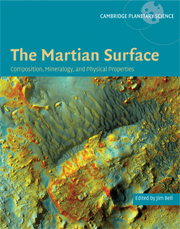Book contents
- Frontmatter
- Contents
- List of contributors
- Foreword
- Acknowledgments
- Part I Introduction and historical perspective
- Part II Elemental Composition: Orbital and in situ Surface Measurements
- Part III Mineralogy and Remote Sensing of Rocks, Soil, Dust, and Ices
- 7 Mineralogy of the Martian surface from Mars Express OMEGA observations
- 8 Visible to near-IR multispectral orbital observations of Mars
- 9 Global mineralogy mapped from the Mars Global Surveyor Thermal Emission Spectrometer
- 10 The compositional diversity and physical properties mapped from the Mars Odyssey Thermal Emission Imaging System
- 11 Mars' crustal magnetization: a window into the past
- 12 Multispectral imaging from Mars Pathfinder
- 13 Mars Exploration Rover Pancam multispectral imaging of rocks, soils, and dust at Gusev crater and Meridiani Planum
- 14 The mineralogy of Gusev crater and Meridiani Planum derived from the Miniature Thermal Emission Spectrometers on the Spirit and Opportunity rovers
- 15 Iron mineralogy and aqueous alteration on Mars from the MER Mössbauer spectrometers
- 16 Magnetic properties of Martian surface materials
- 17 Martian meteorites as crustal samples
- Part IV Physical Properties of Surface Materials
- Part V Synthesis
- Part VI Summary, Upcoming Missions, and New Measurement Needs
- Index
- Plate section
- References
7 - Mineralogy of the Martian surface from Mars Express OMEGA observations
from Part III - Mineralogy and Remote Sensing of Rocks, Soil, Dust, and Ices
Published online by Cambridge University Press: 10 December 2009
- Frontmatter
- Contents
- List of contributors
- Foreword
- Acknowledgments
- Part I Introduction and historical perspective
- Part II Elemental Composition: Orbital and in situ Surface Measurements
- Part III Mineralogy and Remote Sensing of Rocks, Soil, Dust, and Ices
- 7 Mineralogy of the Martian surface from Mars Express OMEGA observations
- 8 Visible to near-IR multispectral orbital observations of Mars
- 9 Global mineralogy mapped from the Mars Global Surveyor Thermal Emission Spectrometer
- 10 The compositional diversity and physical properties mapped from the Mars Odyssey Thermal Emission Imaging System
- 11 Mars' crustal magnetization: a window into the past
- 12 Multispectral imaging from Mars Pathfinder
- 13 Mars Exploration Rover Pancam multispectral imaging of rocks, soils, and dust at Gusev crater and Meridiani Planum
- 14 The mineralogy of Gusev crater and Meridiani Planum derived from the Miniature Thermal Emission Spectrometers on the Spirit and Opportunity rovers
- 15 Iron mineralogy and aqueous alteration on Mars from the MER Mössbauer spectrometers
- 16 Magnetic properties of Martian surface materials
- 17 Martian meteorites as crustal samples
- Part IV Physical Properties of Surface Materials
- Part V Synthesis
- Part VI Summary, Upcoming Missions, and New Measurement Needs
- Index
- Plate section
- References
Summary
ABSTRACT
In orbit on board the European Space Agency's (ESA) Mars Express spacecraft, the Observatoire pour la Minéralogie, l'Eau, les Glaces et l'Activité (OMEGA) visible to near-infrared spectral imager is acquiring a global compositional surface mapping dataset of Mars in order to reveal its major mineralogical and icy constituents. These data provide insights on the evolution of Mars on timescales ranging from seasonal variations to geological epochs. In particular, the identification and mapping of the spatial distribution of pristine magmatic rocks (including olivine, high-Ca pyroxene, and low-Ca pyroxene) and of three classes of altered minerals (hydrated phyllosilicates, hydrated sulfates, and anhydrous ferric oxides) in distinct areas has enabled the development of a new model for the evolution of the surface. The model includes three major eras spanning Martian history. The first era, during which phyllosilicates appear to have formed, was the most favorable to have hosted habitable conditions, with perennial and neutral to slightly alkaline pH surface liquid water. Mars then underwent a global environmental and climatic change, coupled to the formation of Tharsis and the release of large amounts of SO2 and other volcanic gases, and the likely loss of most of its CO2-rich atmosphere. This second era was characterized by low-pH (acidic) surface and subsurface groundwater, and the creation of large deposits of sulfate minerals. The third and most recent era in this model is dominated by atmospheric processes, leading primarily to the generation of anhydrous weathering products.
- Type
- Chapter
- Information
- The Martian SurfaceComposition, Mineralogy and Physical Properties, pp. 151 - 168Publisher: Cambridge University PressPrint publication year: 2008
References
- 5
- Cited by



